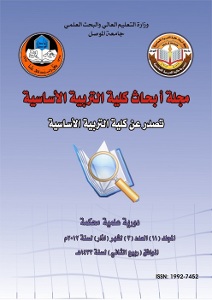The Effect of Using Helda Taba Model in Developing Critical Thinking for the Students of History Department
Abstract
. 2003-2004 (54) (27) (27) (1994) . . (0.87) . . The research aims at the acquaintance with the effect of using Helda Taba sample in developing the erotic thinking of history department students in the college of education . The research community consisted of the second year male and female students in history department in the college of education at Mosul university for (2003-2004) , the sample invaded (54) male and female students distributecl randomly into two groups , the first one is experimental amounted to (27) male and female students who are taught by using helda taba sample , whereas the criterion group involved (27) male and female students who are taught by using the ordinary way , the two groups were equal in age , intelligence and sex , in order to measure the critic thinking , the researcher sought the hap of the method preaxial by Al-Samarraee in (1994) . The method was percentile to group of experts in education an psychology to find the visible truth of the way . According to firmness by repeating test amounted (0.87) . Statistical treatments were made , and the results indictable the existence of differences of a statistical meaning between the two groups for the experimental group which was bought according to helda taba method , also , the experimental group indicated excellency in inferences the acquaintance with the suppositions and ponstnlates contriving and proofs adjustment and the an explanation result space which is asperse of critic thinking , in the light of the results above , the researcher recommended a number of recommendations .






